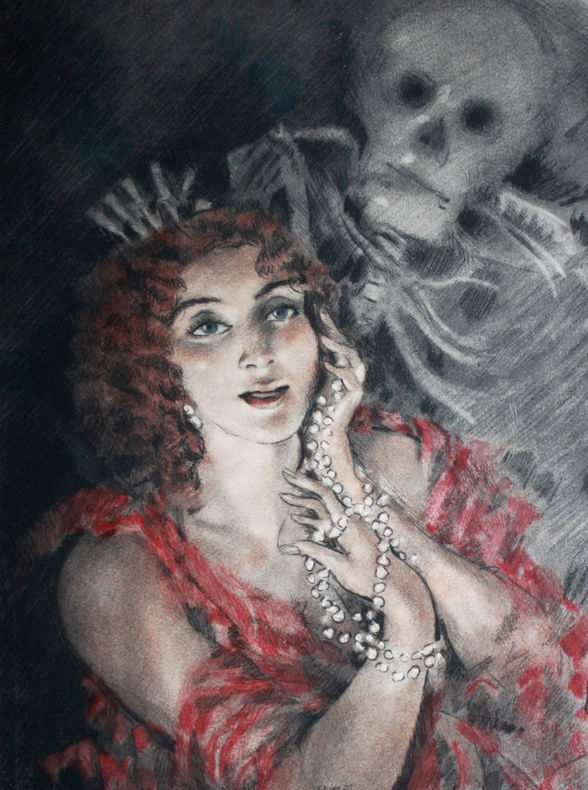
Édouard Chimot (1880-1959) was a French prolific artist who worked as an editor, painter, watercolourist, engraver and draughtsman/ illustrator, editor and even an early film-maker. His career reached its peak during the 1920s in Paris, when he was involved with the publication of fine quality art-printed books.

Chimot was born in Lille, but studied at the École des Arts décoratifs in Nice, before returning north for further study at the École des Beaux-Arts in his home city. It appears that he began exhibiting only in his early thirties (perhaps after a spell as an architect) and then had his career disrupted by military service during the Great War.
During the period just before the outbreak of war, Chimot had a studio in Montmartre in Paris and often sketched in the lesbian bars of the quarter. His first exhibition in 1912 secured a commission to illustrate René Baudu’s text Les Après-midi de Montmartre with etchings of “petites filles perdues“- the little lost girls of the red light district, which was finally published in 1919. This association with bohemian culture was going to remain with him. As he was later to say, “I chose women as my favourite subject- and then as my only one.”
.jpg)

Further commissions followed, for example illustrating the grimly real war novel L’Enfer by Henri Barbusse and Baudelaire‘s Spleen. This in turn led to work with the publisher Les Éditions d’Art Devambez, for whom he was artistic director between 1923 and 1931. Besides arranging artists to illustrate texts, he still worked on some himself, He reserved some choice texts for himself, for example choosing Pierre Louys’ works Les Chansons de Bilitis (1925), Poesies de Meleagre (1926), La Femme et le Pantin (1928), Aphrodite (1929) and, lastly, Parallèlement by Paul Verlaine (1931)- these reflect his continued interest in representing scenes of sex and sexuality. Chimot was also involved in making two films during this vibrant period.
.jpg)
However, the Wall Street Crash of 1929 destroyed the market for costly luxury books in limited editions. Chimot’s work and income was never as assured again. Hence, his work increasingly comprised erotica: in 1931, for example, he issued Maurice Magre’s Les Belles de nuit, lithographs of prostitutes, Baudelaire‘s Fleurs du mal in 1941, Prosper Merimee’s Carmen in 1951 and a collection simply entitled Chats (Pussies) in 1936. He was also asked to provide plates for editions of Louys’ Poems inedits (1887-1924) in 1938 and Trois filles de leur mere in 1950. He described his technique for designing illustrations in an interview in 1926: “I make a lot of drawings in the atmosphere of the text, then I choose among them. The engraving becomes a free translation of my drawing. It then takes me two to four weeks for an engraving; I only make etchings.”

Chimot’s description of his interaction with the text, his search for the ‘mood’ or ‘atmosphere’ (l’ambiance) is fascinating. It indicates the interaction between artist and author: the former must first choose key or representative incidents in a story, and then seeks to get to the emotion and dynamics underlying that particular scene so as to be able to depict them most authentically and effectively. S/he has to identify with the artist’s motivations and reactions and to be able to find an expression of these and of his/her own responses. As I have suggested before, when this is done perceptively and well, the result lifts the entire artwork. It’s worthwhile observing in relation to this that Chimot’s illustrations are often notably faithful to the text: for example, his Mnasidika in Bilitis is as young as Louys indicates and his plates for Trois filles are as explicit as the text demands.
Despite these financial pressures, Chimot still produced some striking art, such as his 1958 portfolio of sixteen female nudes, Les Belles que voilà: mes modèles de Montmartre à Séville (‘Here are the Beauties: my models from Montmartre to Seville’). As the collections’ title indicates, Chimot moved to Spain during the Second World War. It’s fascinating to note that he had a commission with Seville, a city much haunted by Louys late in the last century- especially because of the working girls he encountered there.
For more information on the writings of Louys, please see my bibliography page and details of my own books.

[…] especially from Devambez which was then under the artistic direction of artist Edouard Chimot. Like Chimot himself, Brouet suffered severely from the impact of the market crash and depression […]
LikeLike
[…] lyrical lines and watercolour washes tend towards a happier, more homely sense of the family, or Edouard Chimot‘s lively and brightly coloured illustrations, which help to emphasise the excitement and […]
LikeLike
[…] after Louys’ decease (1925-38)- these include editions that I have discussed elsewhere, by Edouard Chimot (1925), prolific book illustrator Willy Pogany (1926), Jean Berque (1935), Lobel-Riche (1937) and […]
LikeLike
[…] with plates supplied by such artists as Clara Tice, Paul-Emile Becat, Mariette Lydis and Edouard Chimot), as well as my consideration of the other works that drew upon the novels by Louys: plays, operas […]
LikeLike
[…] of the artists commissioned to work on this book are known to us already: Edouard Chimot, Mariette Lydis, Antoine Calbet, Paul-Emile Becat and Jean Traynier. I especially like […]
LikeLike
[…] April 11, 2024 John's Art & Culture Blog art, literature, poetry, Uncategorizedandre collot, art history, classical, classicist, edouard chimot, Georges Pichard, illustration, illustrator, jean berque, leda, louis berthomme saint andre, Manuel de civilite pour les petites filles a l'usage des maisons d'education, parody, pascal pia, pasiphae, Pierre Louys, pybrac, rene ranson, Roi Gonzalve, Rojan, toinon, trois filles de leur mere, utopia, Young Girl's Handbook of Good Manners Teresa & family by Edouard Chimot […]
LikeLike